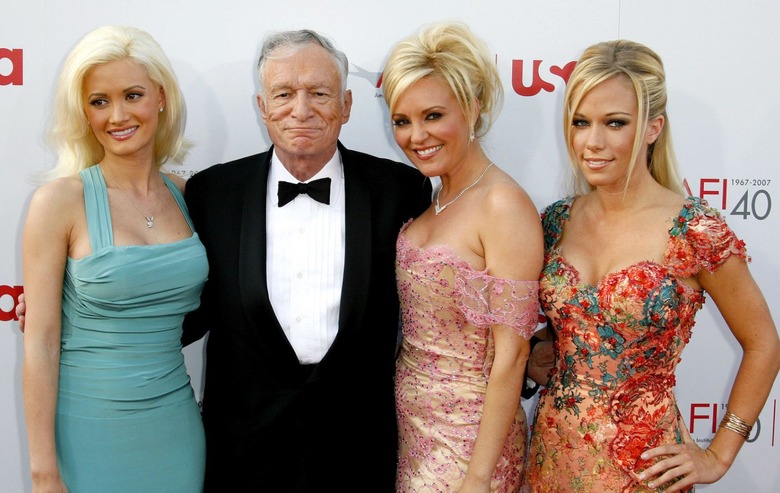What 'Playboy' Taught America About Food And Drink
You can dismiss Hugh Hefner, who died on Sept. 27 at the age of 91, as a self-justifying soft-core pornographer and later an ewww-inducing old goat who bragged about popping Viagra like candy so he could bed women 50 or 60 years his junior, sometimes several at a time. You could also point out, as Amber Batura did in The New York Times a couple of days after his demise, that Hefner was a vocal supporter of gay and women's rights, a champion of the First Amendment, and an enemy of racism not just in his magazine but in his hiring practices.
If you care about food and drink, though, whatever you think of its founder, you should know that Playboy was for many years an articulate, innovative, and influential purveyor of information about the gastronomic arts.
As Batura points out, part of Hefner's mission was to promote an image of modern man as more than an aloof, outdoorsy type, and he did this by, among other things, publishing articles on such "unmanly" pursuits as fashion, art, music, literature — and food and drink. In 1954, in Playboy's second year of existence, Hefner hired a full-time editor to cover these subjects. This was Thomas Mario — aka Sidney Aptekar — who had directed United Nations food relief efforts in Europe after World War II and later become a newspaper food columnist, and who was to remain with Playboy for more than three decades.
During his tenure, Mario contributed countless food articles and recipes to the magazine, and wrote or edited a number of Playboy-branded books on food and drink. The most popular of these was The Playboy Gourmet Cookbook (1961), which included chapters with names like "Charcoalmanship: Cooking on the Outside," "The Opulent Oyster: Homage to a Bacchanalian Bivalve," and "Currying Favor: The Sting of Satan Is the Pathway to Pleasure," as well as recipes for everything from chicken mousse with pistachios to venison chops with chestnuts espagnole.
Mario also signed on a number of distinguished food and drink writers over the years, among them Maurice Zolotow, whose spirits coverage was exhaustive and highly authoritative (his widely reprinted article on absinthe long predated today's interest in that fabled firewater and remains the definitive study of the subject), and the legendary Roy Andries De Groot, whose classic book The Auberge of the Flowering Hearth influenced everyone from John Besh to Frank Stitt to Alice Waters. Among other things, De Groot wrote for Playboy what was almost certainly the first serious article in English about France's seminal nouvelle-cuisine pioneer Restaurant Troisgros (now reinvented in a new location as Maison Troisgros), asking rhetorically if it might be "the world's greatest restaurant."
It was also for the pages of Playboy that frequent contributor Calvin Trillin penned his celebrated paean to the food of his hometown — writing (pace De Groot and tongue definitely in cheek) that "The best restaurants in the world are, of course, in Kansas City," and turning Arthur Bryant's Barbeque into one of the most famous eating places in America.
Playboy's most significant contribution to the modern American food scene, though, is arguably another magazine altogether. In the late 1970s, a couple of Harper's Bazaar arts editors, Michael and Ariane Batterberry, conceived the idea of creating a food magazine that would be worldwide in scope but more accessible than the leader in the field, Gourmet. They dubbed it The International Review of Food and Wine, and found an investor for it named Hugh Hefner. The first issue of the publication appeared as a supplement to the March 1978 issue of Playboy, and the magazine was launched as a stand-alone in May.
The cover of the pilot issue was slugged not with the whole name as envisioned by the Batterberrys, but with the abbreviated title Food & Wine — which is what the magazine came to be called. (It was sold to the publishing arm of American Express in 1983, becoming part of Time Inc. three decades later.)
Hugh Hefner himself was no gourmet. Though he was known to sup on caviar and Champagne with his harem, his usual meals were apparently more plebian. In The Playboy Gourmet Cookbook, Mario reported that Hefner sometimes called down to the Playboy Mansion kitchen for "A BLT. With chips, milk, applesauce. And a blond." A onetime chef at the mansion revealed some years later that his boss's favorite meal was fried chicken made according to his Nebraska-born mother's recipe, accompanied by two scoops of mashed potatoes and two poached eggs. As an oldster, he reportedly dined most nights on a lamb chop and a baked potato. It is not recorded whether or not he feasted on roasted rabbit.
